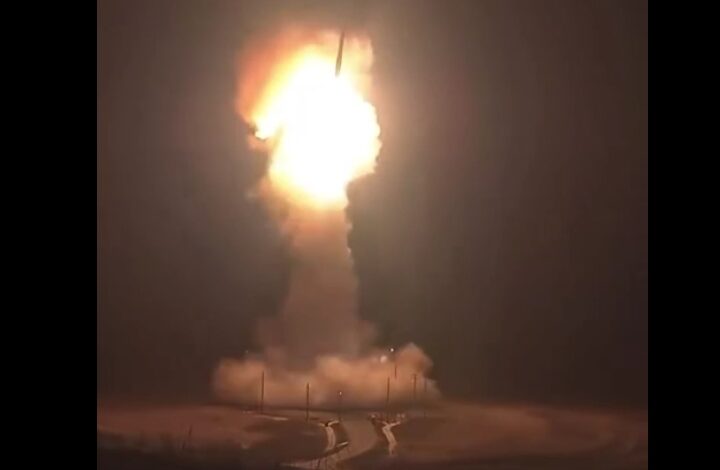
U.S. Poised to Conduct Hypersonic Nuclear-Capable Missile Test Hours After National Election Polls Close: Defense Officials Confirm Effort to Bolster Technological Dominance Amid Heightened Global Tensions
In an Unprecedented Strategic Move, U.S. Poised to Conduct Hypersonic Nuclear-Capable Missile Test Hours After National Election Polls Close: Defense Officials Confirm Effort to Bolster Technological Dominance Amid Heightened Global Tensions
In a surprising move that has drawn widespread national and international attention, the United States military is set to conduct a test launch of a hypersonic nuclear-capable missile in the hours following the close of polls on Election Day, November 5, 2024. The decision to hold this test during one of the nation’s most pivotal democratic exercises has sparked significant interest and debate across various sectors, particularly regarding the geopolitical and strategic timing of this launch.
Overview of the Missile Test
The missile test, which remains shrouded in confidentiality, will reportedly take place at an undisclosed military testing site. Official statements released by the U.S. Department of Defense indicate that the primary goal is to test advancements in hypersonic technology, a field where the U.S., China, and Russia are in an intense competition to develop highly maneuverable, rapid-response weapons systems. Hypersonic missiles, which can reach speeds exceeding Mach 5 (over 3,800 mph), are valued for their ability to elude traditional missile defense systems and deliver payloads to targets within minutes of launch.
Experts in defense and military technology have noted that hypersonic missiles represent a revolutionary leap forward in warfare capabilities. Unlike traditional ballistic missiles, which follow a predictable, arched trajectory, hypersonic missiles can travel at lower altitudes, evading radar detection, and maneuver during flight to outwit interceptor missiles. This flexibility in course correction renders them far less susceptible to interception, a capability that could prove decisive in future conflicts.
Strategic Implications of the Test Timing
While the United States has conducted numerous missile tests in the past, the timing of this particular launch—immediately following a high-stakes election—has drawn considerable speculation regarding its strategic significance. Military analysts suggest that the test may serve multiple purposes, including technological validation, military readiness demonstration, and the signaling of American defense capabilities to other global powers. Given the heightened military activities from both China and Russia in recent years, the hypersonic missile test could be viewed as a reminder of U.S. advancements in military technology.
The test also coincides with a period of domestic political focus, as the nation’s attention is fixed on the results of key elections. Some observers see this as an opportunity to stress the U.S. government’s continued dedication to national security regardless of domestic political shifts. The test can be interpreted as a reassurance to both domestic and international audiences that the United States maintains a high level of preparedness amid ongoing geopolitical uncertainties.
Technological Advancements and Challenges in Hypersonic Missiles
The pursuit of hypersonic missiles is part of a broader movement among global superpowers to advance next-generation weaponry. These missiles operate on the cutting edge of physics and engineering, with their extreme speeds presenting both technological advantages and unique challenges.
To function at hypersonic speeds, missiles must withstand immense frictional heating caused by air resistance. The material science required to protect the missile’s structure, maintain the integrity of its guidance systems, and ensure the reliability of its payload is complex and costly. Furthermore, hypersonic missiles must balance speed with maneuverability. Unlike ballistic missiles, hypersonic missiles must be equipped with advanced navigation and steering mechanisms to adjust their trajectory during flight, allowing them to avoid interception but also placing additional stress on onboard systems.
The United States is reportedly exploring a variety of hypersonic delivery systems, including both glide vehicles and air-breathing missiles. Glide vehicles are launched into the upper atmosphere before diving back toward Earth at hypersonic speeds, while air-breathing missiles utilize scramjet engines that draw oxygen from the atmosphere, reducing their weight and enhancing fuel efficiency. Both technologies are aimed at making these missiles versatile tools for different military applications.
The Global Race for Hypersonic Dominance
The United States is not alone in pursuing hypersonic missile technology. China and Russia have invested heavily in developing similar systems, with each nation aiming to secure a technological edge that could provide strategic advantages in future military conflicts.
Russia’s Avangard hypersonic glide vehicle, capable of carrying nuclear warheads, was reported to be operational as of 2019, making it one of the first hypersonic weapons to enter service. Russia claims that the Avangard can reach speeds of Mach 20, making it virtually impossible to intercept with existing missile defense systems. This capability is seen as a critical deterrent by Moscow, especially in light of NATO’s expanding influence in Eastern Europe.
China, too, has made substantial advances in hypersonic technology. The DF-ZF, a Chinese hypersonic glide vehicle, has undergone multiple successful tests and is believed to be capable of evading advanced radar and missile defense networks. According to analysts, China’s hypersonic advancements are driven by its desire to counterbalance the United States’ Pacific presence, particularly concerning Taiwan and other contested areas in the South China Sea.
The strategic implications of hypersonic missiles extend beyond raw speed and maneuverability. These weapons reduce response times in potential conflicts, complicating the decision-making processes for military and political leaders. Because hypersonic missiles can reach targets much faster than traditional ballistic missiles, they leave little time for defense forces to respond, increasing the risk of rapid escalation in military confrontations.
Reactions from the International Community
The timing of this missile test has sparked discussions and reactions worldwide. Several international entities have expressed concerns over the test, with some viewing it as a provocative act during a period of global instability. Leaders from countries such as China and Russia have indicated that the U.S. missile test could spur a new arms race, encouraging further development and deployment of similar weapons in other countries.
In Europe, NATO officials have voiced cautious support for U.S. advancements in hypersonic technology, seeing it as an essential deterrent against potential threats from adversarial powers. However, NATO members have also underscored the need for continued dialogue on arms control to prevent the spread of hypersonic missiles and avoid destabilizing the security balance.
Within the United Nations, diplomats have called for renewed discussions on international arms agreements that could place limits on hypersonic missile development and deployment. Some advocates suggest that a new treaty akin to the Intermediate-Range Nuclear Forces (INF) Treaty, which the United States and Russia abandoned in 2019, could help curb the hypersonic arms race and ensure that emerging weapons technology does not escalate global tensions.
Domestic Reactions and Public Opinion
Within the United States, news of the missile test has prompted mixed reactions. While some citizens view it as a necessary measure to maintain national security and technological superiority, others are concerned about the test’s timing and potential consequences. Public opinion polls indicate that many Americans are uneasy about the increasing role of advanced weaponry in U.S. foreign policy, fearing that hypersonic missiles could inadvertently lead to heightened tensions and conflict.
Lawmakers have also weighed in, with some members of Congress calling for increased oversight of hypersonic weapons programs. Concerns have been raised about the immense financial costs associated with these programs, with some estimates suggesting that the development and deployment of hypersonic systems could cost tens of billions of dollars over the coming years. Additionally, there are calls for greater transparency regarding the environmental impact of hypersonic tests, as the energy and materials required for these launches often result in significant emissions and waste.
On the other hand, several defense advocates within Congress have praised the missile test, arguing that it showcases America’s readiness to defend its allies and maintain a strategic advantage over its adversaries. According to these proponents, advancements in hypersonic technology are essential for the United States to counterbalance the growing military capabilities of countries like China and Russia, which have both made substantial investments in hypersonic weaponry over the past decade.
Potential Outcomes and Future Prospects
The hypersonic missile test represents not only a technological milestone but also a potential shift in the dynamics of modern warfare. If successful, the test could open the door for broader deployment of hypersonic weapons within the U.S. military, potentially leading to an expansion of the nation’s nuclear and non-nuclear deterrence strategies.
However, the deployment of hypersonic missiles would likely trigger further arms development in other countries. Experts warn that an unchecked arms race could destabilize global security, as nations compete to develop ever-faster and more advanced weapon systems. Some military analysts suggest that hypersonic missiles could make traditional arms control agreements obsolete, as existing frameworks do not account for the speed, accuracy, and versatility of hypersonic weapons.
To address these concerns, there are calls for international arms control discussions that include hypersonic weapons within their scope. While the challenges of regulating such advanced technology are substantial, diplomatic efforts may be the best means of preventing an unrestrained hypersonic arms race.
Conclusion
The upcoming U.S. hypersonic missile test signifies a bold step forward in modern military technology, one that could redefine the landscape of defense strategy and international relations. By conducting the test shortly after the election, the United States appears to be sending a clear message about its commitment to national security, technological innovation, and strategic deterrence. As the world watches closely, the test underscores the complexities of maintaining peace and stability in an era where the boundaries of military technology are rapidly expanding.
Whether this test will serve as a catalyst for increased collaboration or intensified competition remains to be seen. But as hypersonic technology advances, so too must the frameworks and policies that govern its use, to ensure that it serves as a tool of deterrence rather than a trigger for conflict.



